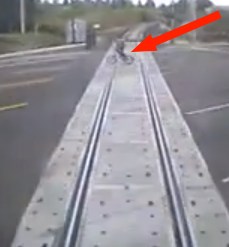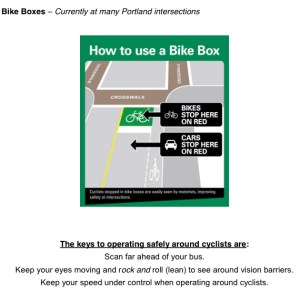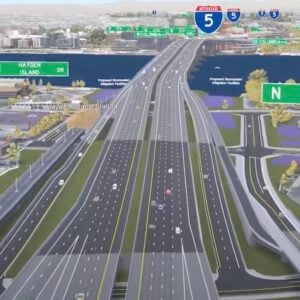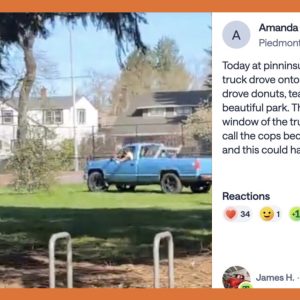
TriMet is trying to get the word out about safety when it comes to WES Commuter Rail trains and conflicts between buses and bikes. As part of a summer safety campaign that kicked off Monday, the agency has released five videos showing close calls between people crossing tracks in front of WES trains. They have also sent out a new, in-depth training bulletin to all bus drivers that is focused specifically on bicycling.
One of the videos shows a person on a bicycle crossing the path of an 80-ton WES train that’s a mere 60 feet away. According to TriMet, WES trains traveling 55 mph take about a half-mile to come to a stop. The incident with the bicycle rider happened on September 15th near SW Scholls Ferry Road in Beaverton. Here’s the video:
TriMet’s safety campaign also includes “enforcement and awareness missions” from the Transit Police Division and railroad authorities throughout the summer, “to remind people to be aware of approaching trains, obey warning devices and stay safe near the tracks.”
TriMet is also reminding folks that you could be given a citation and a $242 fine for “failure to stop for a railroad signal.”

In other TriMet safety news, today a reader emailed me a three-page TriMet document titled, Training Bulletin: Cyclist Awareness and Safety (PDF). The bulletin, that’s being sent out to all TriMet operators, is an in-depth look at cycling. It covers what behaviors bus operators should expect from people on bikes, a review of relevant traffic laws, how to deal with intersections, passing, and more.
Here’s a snip from the intro:
“Cycling is growing and will continue to grow… People cycle for pleasure and for transportation. Some cyclists belong to and ride with clubs. More and more however, people are cycling to commute to work, shopping or school… The cyclist you see every day may be a friend, neighbor, or one of your customers. They may even be a co-worker.”
Thankfully, the bulletin explains to bus operators that “cyclists are vulnerable” and that people encounter all sorts of “problems” out on the road while riding including:
- Narrow and unfriendly roadways
- Edge of the road is often in bad condition
- Debris blows to side of the road.
- Storm grates
- Potholes
- Parked cars
Here’s how the bulletin urges operators to deal with passing someone on a bike:
Passing – Be aware of your draft.
- Scan far ahead to spot cyclists early.
- Pass with at least a minimum of 4-feet of space.
- Buses push air to the sides so reduce your speed if the cyclist is moving much slower than you.
- Avoid passing unless necessary – the safest place is for them to be ahead of you.
- Pass only at wide spots, or split or change lanes to create enough space to safely pass.
- Confirm your clearances in the mirror as you pass.
And here’s the section on yielding to people in bike lanes:
Bike Lanes – Yield to cyclists
- Anytime you cross or enter a bike lane to turn, to change lanes, to park, or to make a service stop, you do not have the right of way, you must yield to cyclists.
- You may enter a bike lane to make a service stop, but yield to any approaching cyclists.
- Be aware of the potential for cyclists to appear from behind your bus when you exit a stop.
- Clearly signal your exit prior to exiting and if you moving out from the curb, use the Yield Light.
The bulletin shows an impressive amount of detail and understanding about how people ride bikes and the safety issues they present to bus operators. I think it’s safe to say that existing in America’s most bike-friendly city has had some positive impacts on TriMet management. I hope operators take the time to read it, absorb it, and then act accordingly. (And please don’t assume that last line means I don’t think people on bikes have any responsibility in this equation. They do. Obviously. Thank you.)
Download the bulletin here (PDF).







Thanks for reading.
BikePortland has served this community with independent community journalism since 2005. We rely on subscriptions from readers like you to survive. Your financial support is vital in keeping this valuable resource alive and well.
Please subscribe today to strengthen and expand our work.
“Cycling is growing and will continue to grow… People cycle for pleasure and for transportation. […] More and more however, people are cycling to commute to work, shopping or school… The cyclist you see every day may be a friend, neighbor, or one of your customers. They may even be a co-worker.”
Hats off, TriMet. I think that kind of language should be in lots and lots of training manuals, starting with the Driver’s Manual.
I really liked this part too!
Encouraging. Nice.
That biker in the video is just plain nuts!
At least he was careful enough to cross the tracks at 90 degrees. We wouldn’t want another cyclist complaining on here about dangerous tracks.
“Anytime you cross or enter a bike lane to turn, to change lanes, to park, or to make a service stop, you do not have the right of way, you must yield to cyclists.”
The driver of the 14 who nearly ran over myself and 10 other people on bikes at Hawthorne and 6th yesterday around 4:00 must not have gotten the memo.
These memos are great, but I think many of these drivers need to have plain clothes check ride instructors riding with them to make sure they actually do it. I’ve been passed within inches by many a Trimet bus and I’ve seen horrible driving skills and lack of understanding (or caring) of the law by many drivers as well. Of course there are the good drivers too, and to them I say a hearty “Thank You”.
The difference now, is that TriMet has published this as their policy. It will help you file a grievance; and if you have the unfortunate situation to have to bring a case against a driver, this will help.
The safety training is great but I’m still a little discouraging based on my recent experience with TriMet busses.
Just about every bus I’ve climbed on in the last month (usually traveling between downtown Portland and southern Washington County) has been driven by someone who was so agressive they were knocking people from their seats as they accelerated and braked. Off-hand I can think of only one trip on the bus in the last month where passengers were not having trouble staying upright.
I also regularly see bus drivers at the Beaverton Transit Center using their busses to push their way through crosswalks full of people. The busses have a stop sign and the people in the crosswalk have the right of way but the busses intimidate people by lurching forward, inches from the crosswalk.
I’ve reported descriptions of drivers and bus numbers for all the scenes I’ve witnessed and had the information for, and TriMet has responded with their generic complaint response message. However, I still see the drivers I’ve reported on the road, behaving the same way. Occasionally I’ll see a driver I reported transfered to another bus line.
I ride the WES maybe 6-8 times a week and I’ve seen just 2 or 3 people do dumb stuff near the train in the last 6 months or so, but that’s certainly still a problem that needs to be address.
In comparison, there hasn’t been a single trip I’ve taken on the bus in the last few months where the driver’s behavior did not cause me at least some concern. Consequently, I’ve been riding the WES and MAX more. (Maybe I just have bad luck with drivers on the few trips I still take on the bus?)
All I hope is that the new, improved bus safety training will help drivers understand that they’re sharing the road with actual, living human beings.
I was amazed and thrilled by the behavior of the driver of the #12 bus I took back to the Eastside from Barbur TC yesterday morning. She was very cautious pulling in and out of stops, watched for and yielded to people on bikes multiple times, and generally had a most unhurried and serene demeanor that impressed me very much. I wonder if part of what you’re experiencing Will has to do with unrealistic schedules that the drivers (feel they) have to hurry to keep up with?
I think that’s precisely the problem.
In the evening the #12 is the only bus running along Barbur/99 and it’s so infrequent that it’s almost always full, standing room only, and people need to get on or off at most of the stops, slowing the bus down.
The timing of the #12 is about the same as it was when it was running more frequently but with less frequent busses, the busses that still run are taking much longer to make the trip.
Personally I feel that driving safely should supersede any concerns with the schedule, but you’re absolutely right: there are too few drivers trying to serve the demand along the #12, which pushes the drivers to go faster between stops.
Publishing their expectations is great, I think they also need to show videos of bus drivers behaving dangerously, it’s not always “us” that are wrong. I had an encounter where it appeared the driver saw me yield, then a few blocks down, pulled right without yielding (caught on video: https://vimeo.com/45686935), glad the car driver left me space to go left.
Oops, video link should be, http://vimeo.com/45686935
Your video quality is awesome.
Since you say the video is at 170 FOV, how far ahead is the bus? It seems to be about 1/2 a block, maybe 100 feet. At 100 ft, I would not expect a bus to yield. Not sure what the law is.
Thanks. I believe it was only about 2 car lengths or so. At my a bit over 20mph I would have had to really hold on the brakes to stop. That’s kinda the downside with the super wide angle videos, distance is really hard to capture accurately.
based on the comments above, it would appear that there is a disconnect between the training instructions and how TriMet driver performance is actually measured, which, as I understand it, is based almost entirely on maintaining their schedules (as long as they don’t actually hit anyone or anything while doing so).
“You may enter a bike lane to make a service stop, but yield to any approaching cyclists.”
Whoa, really? For TEN YEARS I assumed the opposite, apparently because I seldom see the “correct” behavior.
Until about 5 minutes ago I thought Tri-Met buses had a special dispensation over bikes in the lane (kind of like their magic “yield” light, but without the light). On any given day I’m likely to be cut off at least once by a bus pulling to the curb, especially on Terwilliger, Barbur, or Capital Highway/Vermont.
Yes–I was cut off just yesterday by a bus on Beaverton-Hillsdale Hwy.
This.
I got the impression that the line in the vehicular code allowing buses to use the bike line for stops basically legitimized their bullying tactics to get in to and out of the bike lane.
Effectively excusing any dangerous behaviors under the thought process “I GOTTA JOB TO DO!!! GET OUTTA MY WAY OR I’LL SQUISH YA!!!”.
The law may not have explicitly proscribed these actions but its vagueness in not prohibiting this behavior leads directly to this “bus on bikes” aggressiveness.
I would say that while everyone on the road is essentially sharing the same space, buses and bikes are at the top of the pyramid for interacting in and competing for the narrow part of the road they are mostly limited to. The two modes are just set up for conflict, with people transporting themselves on bikes feeling threatened and hampered, and people transporting others on buses dealing with everything that impedes that process. Cars to the left, bikes to the right, peds in the crosswalk.
I’ve ridden in traffic for years, so I know the conflict is real, but I’ve driven a bus, too, and I can vouch for the fact that the stress of trying to get your job done while being impeded by many and respected by few can be really overwhelming.
I watched all the videos via Joseph Rose’s links on OregonLive yesterday… except the one where the kid is trying to catch up to their parent my thoughts were basically “so what? the problem will take care of itself!”
now I know that’s fairly callous if somebody gets killed by a train… it’s very inconvenient to the driver… but it’s the best lesson that can be taught… publicize the actual collisions, not the close-calls…
I only see the videos as glamorizing train racing, not as a deterrent… everyone makes it so “hey, I could totally beat that train if that guy did it”…
sorry, but let’s see some blood if you want people to stop…
Yeah, that’s pretty callous all right.
There’s a difference between publicizing the fatalities — which we should definitely do — and wishing them on people who make stupid mistakes.
yeah, publicize the blood so everyone can cry out in horror at how trimet is killing people, yet hide the stupid acts that lead up to the incident….
Yes, it would be bad press for Trimet or any transit agency.
But at what point do we allow people born in “The Land of The Free” to be free to suffer the consequences of poorly chosen expressions of freedom?
Should we be proud of the person that dies driving their car over a Hwy 101 cliff in a flaming fireball because it was their own decision?
Should we be upset at the apparently suicidal behavior of the next person that gets killed at a train crossing, not because of temporary inconvenience, but because of the cost wasted investigating and attempting to mitigate future failed death defying acts?
At what point does an organized and civilized society no longer have a requirement to feel empathy for those that bring misery upon theselves through intentional acts?
ummm… ok. the fact that i completely agree with what you write aside, what does this really have to do with my comment? not once do i imply that we should feel “proud” or “empathetic” towards another persons stupid act.
what i did do is disagree with spiffy’s suggestion that one should disregard/hide/destroy any and all evidence of a continued pattern of stupidity (simply because he feels such evidence in and of itself will do nothing to change the behavior,) and instead focus only on the deathblow with all the carnage and blood splatter.
Yeah, I missed your sarcasm on the first part.
Truth be told there is a short term economic benefit to hiding the gore from public and press over-reaction: public funds are wasted on PR spin and double and triple check investigations of what would otherwise be a simple cut and dry matter.
I think history stands behind me when I state that no effort to hide knowledge from the general public is ever 100% successful over time making any effort 100% futile. The public does find out and then the real costs kick in.
I don’t know if the “no recriminations corporate after actions improvement meeting” style of thought will ever catch on with the general public; it seems collectively we must have someone to blame and punish and you can’t punish the dead.
I had an epiphany a few months back (based strictly on my accumulated anecdotal observations): when given a choice between safety and speed, almost everyone–drivers, cyclists, pedestrians–will take increased risks if it will save them a couple of seconds.
Perhaps it is the “it won’t happen to me” syndrome; I can’t believe anybody is in enough of a hurry to consciously risk getting hit by a train. As with bicycles, it is notoriously difficult to estimate the speed of an oncoming train, meaning the risks of trying to beat one are probably higher than people think.
It is very difficult to estimate risk of something you don’t understand.
The learning and thoughtful intelligence genes are only passed on if the victim lives. As much as I might not miss some deficient individual like this contributing to the gene pool wishing them dead doesn’t help unless you are willing to let a lot more people die.
As sad as it is for me to say the following I think it is true in all its diverse implications: “Institutionalized safety programs are society’s way of ensuring that people don’t have to think about their own safety.“
This is an awesome bulletin – would be good for all drivers to read. Most of my interactions with buses have been in Washington Park, and nearly all have been good, with the exception of the time a bus needlessly passed me on a blind turn and then came back to the right too soon, at an angle that forced me off the shoulder of the road into a ditch. Kind of scary.
Must be nerve wracking driving a bus down Williams and Vancouver having to watch for people on bikes, especially with idiots like the one featured in this video. The drivers with the NE Williams route must be stoked on the new design.
it may be that a train moving at 55 mph would require a half mile to stop, but a train should not moving at 55 mph at a level crossing.
in fact, i will suppose that a train does not move at 55 mph at a level crossing, so the juxtaposition of this statement with the statement that the cyclist crossed at a distance of sixty feet would be [intentionally] misleading.
Did you just make that up, or is there some basis for this statement? I was pretty sure this wasn’t true, so I looked it up and:
“U.S. Federal Railroad Administration regulations restrict trains to a maximum speed of 110 mph at standard grade crossings. Crossings are permitted up to 125 mph only if an “impenetrable barrier” is in place to block traffic when a train approaches. Crossings are prohibited at speeds in excess of 125 mph.”
are you talking about a train on a rail that goes to some other town or across the country, where the level crossings have, y’know, gates? or are you talking about a max line in an urban setting where the crossings are just kinda there? i mean, yeah, i am “making it up” in the sense that i have not checked out any laws or regulations on the subject, but common sense sort of tells me that, well, first of all, the max never goes anywhere near 125, so obviously you and i are talking about two entirely different things, but common sense tells me that a light rail does not do 55 mph at level crossing with a street that other people are using for just getting around on in an urban setting.
Re-read the article. This is WES, not MAX. WES is commuter rail, sharing right-of-way with freight trains. All major crossings are gated with flashing lights. Max does not exceed 35mph at signalized crossings. It does at gated crossings, however.
i am looking at the video and i do not see gates
Then you are not looking at the video. There are gates.
those nifty little red&white striped bars that cross over the lane on either side of the track, the ones with the flashing lights above them and the stopped “motorized” vehicles behind them. those are called gates.
Look harder. 0:06 seconds, there’s a red and white gate down in front of the white truck. There are also flashing signals up above the road. And the rest of the traffic is stopped. Those should be sufficient clues to a cyclist that a train is coming, regardless of speed.
How about you just admit that statement wasn’t intentionally misleading, and hopefully think about how quickly you jumped the gun this time before you make such a statement again?
There are definitely gates down. Go full screen if you have to.
Also, I can pretty much ascertain this rider was trying to beat it by the way he was riding. Off the saddle, passing stopped cars on the right to get around the gate–didn’t exactly look like your typical bike commuter by any stretch.
Really? It looked very much like the typical (your mode here) commuter to me.
I spent 2 unfortunate days in the NY Port Authority bus terminal back in 1970 (another story altogether), and for each morning and evening commute, the buses, subways, stairs, escalators and elevators were crowded with thousands of people less than a hair’s breadth away from one another at times, but as distant and remote as if each were isolated in a glass vial, careful not to intrude on one another’s space with the sole intent of getting to their destination; home or work. No eye contact, no speaking, no interaction whatsoever. That is what I see in this picture. He’s less than a second away from death or injury, but has calculated the risks and decided to take it.
I will admit the video is grainy and it is not easy to see, but when I go full screen on the video, I am seeing what looks like standard 20″ bmx wheels. Not really the type of bike your “typical commuter” rides.
Look when I was that age (and I imagine many of us), I did a lot of stupid things like darting out in traffic and lauching myself off homemade bike ramps that threw me 6′ in the air.
Amtrak trains routinely cruise along at 79mph, even at level crossings in urban/suburban areas. Honestly, what is the problem? If you are waiting at a red light along TV Highway, you will see dozens and dozens of cars cruising by at 55mph. How is a train, moving on a track, with flashing lights and lowered crossing gates dangerous in comparison?
I watched the sheriff blast down Williams at about 50 today (a shooting incident was going on) as I watched I noticed from the whole string of bikes not one stopped, looked back, or anything, they rode right on through their intersections with no worries that whatever emergency vehicle was not going to turn where they were. If they did have to stop it would have meant they would have been one minute late getting home, and it’s so hard to start again after you do stop. The sound of a siren blaring, coming towards you at high speed means nothing.
You need to be especially cautious on a bike when emergency vehicles are present. Cars will often shoot into the bike lane in a panic without checking first. I move over as soon as I can locate the source of the siren. This is typically well before the cars notice, and gets me out of harm’s way.
Now if we can get a similar campaign for the Portland Police. I saw a police cruiser illegally pull into the bike box at Madison and Grand in an attempt to make an illegal right turn on red. If the cops aren’t going to obey the laws, how can we expect anyone else to obey them.
Wow. Having a bad day?
Southbound Amtrak trains are rapidly accelerating and already near 55mph when they cross Milwaukie Ave near my house. Not a big deal if you have the sense to stop for the flashing lights.
Looking at this video and guessing the age of the kid pulling this stunt (maybe 13?) harkens me back to the day when I was about that age and thought it was fun to play chicken with cars on busy cross streets. Not sure I would have tried my luck with a train, but never know. I agree with some of the posters that showing this may just make some other young kid think it would be fun to get a rush like that and try it.
and can anyone say: “darwin?”
Agreed, 9Watts.
Regular returns to that training should also be part of the policy.
When hired, most companies provide a safety manual. Many revisit it with their employees regularly, although most don’t unless an incident occurs.
While the costs of gathering employees over a period of time and venues may be considerable, like the large employer TriMet is, it is cheap in comparison to a multimillion $ lawsuit.
Lots of good points here, and I get it that there are bus drivers who are too aggressive, angry, etc, to be safe. And there are people in other modes who make poor judgements or just travel like jackasses. Just want to remind everyone that, having been a bus driver, I can attest that it is a very stressful job, with many challenges, few rewards and almost no respect from other road users or passengers. Also remember that (regardless what you may think about Trimet benefits) transit drivers are keeping cars off the road, and they’re not getting rich doing it. Anyone who thinks a bus driver has it easy can try doing it for a year. I think there’s a design and culture problem where bus people and bike people are required to dice it out on the shoulder, while cars whizz by in the left lane(s). And those on the shoulder are blaming each other for making it an uncool scene, when it’s really everyone else putting them in that situation in the first place.
Maybe they could have a high power water canon on the front of the train that the conductor could blast somebody out of the way with at the last second right before impact